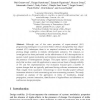72 search results - page 10 / 15 » Crosscutting Concerns in J2EE Applications |
ICSM
2006
IEEE
14 years 23 days ago
2006
IEEE
One of the main promises of aspect-oriented programming (AOP) is to promote improved modularization of crosscutting concerns, thereby enhancing the software stability in the prese...
SAC
2005
ACM
14 years 8 days ago
2005
ACM
More and more software projects are using COTS (Commercialoff-the-shelf) components. Using COTS components brings both advantages and risks. To manage some risks in using COTS com...
AOSD
2003
ACM
13 years 12 months ago
2003
ACM
Persistence - the storage and retrieval of application data from secondary storage media - is often used as a classical example of a crosscutting concern. It is widely assumed tha...
ECOOP
2007
Springer
14 years 27 days ago
2007
Springer
Although one of the main promises of aspect-oriented (AO) programming techniques is to promote better software changeability than objectoriented (OO) techniques, there is no empiri...
ECOOP
2006
Springer
13 years 10 months ago
2006
Springer
Aspect-Oriented Programming (AOP) is a powerful technique to better modularize object-oriented programs by introducing crosscutting concerns in a safe and noninvasive way. Unfortu...

